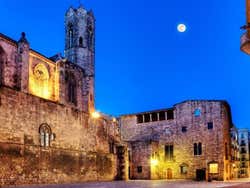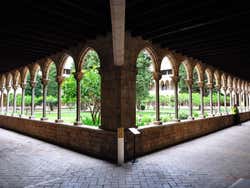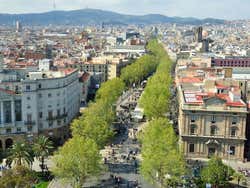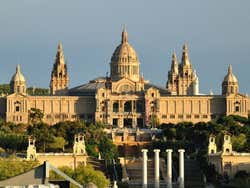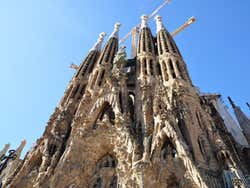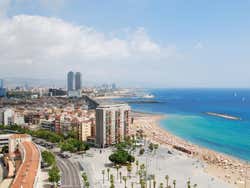History of Barcelona
Discover the enthralling history of Barcelona from when it was first settled to the present, now a modern and surprising city.
Foundation: The Romans
The earliest historical data in Barcelona begins with the first human remains in the area, dating back to 2500 BC and the existence of the first settlement dates from between 2000 and 1500 BC.
According to Rufo Festo Avieno, a Latin poet born at the end of the fourth century, Barcelona and its surroundings was home to two Iberian villages: one on Mont Tàber, whose name is unknown. This hamlet has been called Barcilo, Barcinom or Barkeno by various historians and is believed to be the origin of the name Barcelona. The other settlement was called Laye and was founded on Montjüic. It was inhabited by the Laietani.
The Romans invaded the area in 218 BC and established themselves on Montjüic, where they built a fortress. During Caesar Augustus rule, the Romand moved to Mont Tàber, where Plaça de Sant Jaume currently is. This is the origin of Barcelona, under the name of Barcino.
During the third century, Barcino was destroyed by the Germanic tribes. It was then reconstructed and fortified with an enormous city wall of over 100,000 square meters long. The wall demonstrates just how important the city was for the Romans.
In 415, the Visigoths led by Ataulf attacked Barcino after crossing the Pyrenees fleeing from Southern Gaul. Barcelona was declared the seat of Ataulf’s court for a few days before he was killed and the capital of the south of France was moved to Toulouse.
Barcino was controlled by the Visigoths for three centuries until, between 717 and 718, it was captured by the Moorish forces. Moorish rule lasted a little less than a century.
In 758, the local Walï wished to declare independence from the Emirate of Cordoba ruled by the Umayyad dynasty. To do so, he allied with the French, which led them to struggle for power, until Louis the Pious captured Barcelona in 801.
County of Barcelona
In 801, once the city was taken from the Muslims by Louis the Pious, son and vassal of Charlemagne, the Franks formed the County of Barcelona, integrating it into the Spanish dominations within the Carolingian Empire.
The County was a small area bordering the County of Girona and the County of Osona. In 803 the Franks named Bera, a Gothic tycoon, the first Count of Barcelona.
For a century the County was ruled directly by the Frank counts. The County of Barcelona suffered incursions of Islam in the years 827, 850, 852 and 856.
In 878 Louis the Stammerer named Wilfred the Hairy Count of Barcelona and Gerona. He was also count of Sardinia and Urgell. Wilfred (878-897) gave the county a leading role over the other Catalan counties.
Count Sunyer extended his influence to the Ebro Delta. Although his successors were in fact vassals of the Muslims, they did not prevent numerous raids, the most damaging being that of 965. Twenty years later, in 985, Almanzor attacked the city, destroying it.
Borrell II, Count of Barcelona, Girona, Osona and Urgell separated himself from the authority of the Frankish monarchs by not coming to Aquitaine to pay homage to the new French monarch Hugo Capeto, on the pretext that the Franks had not helped him in the face of the razzia of Almanzor.
The unions and disunions with the neighboring counties of Urgell, Osona and Girona were continuous due to the historical sway of inheritances and pacts.
It was with Ramon Berenguer I that the County of Barcelona acquired more importance, extending its power to Ribagorza and, to the south, to near Tarragona, in turn slowing down the possible expansion of the counties of Sardinia, Urgell and Pallars, and even collecting outcasts from the Moorish borders.
Count Ramon Berenguer II wanted to conquer Valencia but the Cid prevented him from doing so.
Ramon Berenguer III married the heiress of the County of Provence. The two counties together began a phase of international expansion, and in 1114 they temporarily conquered Mallorca. The union of Barcelona and Provence was dissolved on the death of Count Ramon Berenguer III.
In 1137 Ramon Berenguer IV, to avoid the cravings of Castile, married Petronila, the daughter of Ramiro II of Aragon, and the County of Barcelona was integrated into the Crown of Aragon.
Barcelona during the Crown of Aragon
The union with the Kingdom of Aragon favoured the expansion of the County of Barcelona throughout Catalonia and the fact that Barcelona became the political and economic centre of the new Crown of Aragon. Barcelona was the venue for the celebration of the Cortes de la Corona de Aragón on several occasions.
The strong expansion of the Crown of Aragon over the Mediterranean, which became one of the powers of the time, made Barcelona one of the most important cities in the Mediterranean.
King James I founded the municipality of Barcelona in 1249, stipulating that it would be governed by five Consellers and by the Consell de Cent.
Prosperity continued until 1333, when famine and plague killed thousands of people in Barcelona, and four years later the city was devastated and decimated by the Black Plague.
The plague would not leave the city, which it continued to plague during the 15th and 16th centuries.
In 1401 the first public bank, the "Canvis Taula", was founded in Barcelona.
In the 15th century Barcelona went from bad to worse. The excessive increases in prices and wages led to a major economic crisis. Some of the trade with the East was lost and the two factions into which the city was divided, the "Busca" and the "Biga", clashed in a struggle to evade their responsibilities.
The currency was devalued, foreign trade fled to Valencia and the textile industry came to a standstill. The "war of the remences", peasants against their lords, and the war with John II of Castile, ended up ruining the city.
At the end of the 15th century, the "privilege of insaculation" granted by Ferdinand II of Aragon to many cities, a privilege that consisted of distributing the municipal power among the local oligarchy by lot, lowered the level of confrontations and began a period of slight prosperity for the city.
From the medieval world to modernism
The link between Ferdinand II of Aragon and Isabel of Castile, the "Catholic Monarchs" unified both kingdoms and, in the new union, the Crown of Aragon and Barcelona, as the de facto capital, began to lose importance in favour of the most powerful Castile.
Barcelona developed the military naval industry and benefited from the precious metals trade between Seville and Genoa. At the beginning of the 17th century Barcelona began to mint a pure copper coin and in 1609 founded the Banc de la Ciudat.
The 17th and 18th centuries were difficult for Barcelona. The possessions of the Mediterranean had been lost, the banditry favoured by the struggles between the oligarchs put an end to the land trade and, as if that were not enough, it suffered during the War of the Spanish Succession.
The Civil War or the Reapers' War arose as a result of the liens that the Spanish Crown imposed on their territories to maintain a diminished empire and to defray the costs of the 30-year War with France.
The Catalans rose up against the new taxes and, supported by Richelieu's France, started a war in which the only winners were the French, who took half the territory of Catalonia, a territory north of the Pyrenees that would never cease to be French.
The War of Succession pitted half of Europe against each other for succession to the Spanish throne, between the supporters of the Bourbons and those of the Habsburgs. The Crown of Aragon and Barcelona were in favour of the Hapsburgs who promised to keep their privileges. But the Austrians left Catalonia to their fate and after the Treaty of Utrecht, Catalonia passed into Bourbon hands.
The wars left Barcelona bankrupt. When the Spanish and French troops conquered the city they found it totally ruined. After Barcelona's support for the Hapsburgs, the new king, Philip V, began a radical transformation of the current status of Catalonia.
In 1716, Philip V issued the Nueva Planta Decree, the purpose of which was to unify his empire and suppress local jurisdiction. Barcelona lost the insaculation regime, the suppression of the Cortes, the Consell de Cent, the Generalitat, the disappearance of the mint, the university was moved to Cervera and Spanish was imposed as the administrative language.
After the War of Succession, trade with America and the rest of the peninsula turned Barcelona into a prosperous city. He developed a powerful industry, mainly textiles, which led thousands of workers to immigrate to the city.
The weight of the working class in the city would henceforth be the cause of great social mobilizations. Thus, in 1854 the workers began the first general strike in Spain.
Barcelona began a few decades of great economic strength, of great urban changes, and suffered all the vicissitudes of the turbulent 19th century.
In 1848 the first railway was inaugurated, in 1854 the walls were demolished, in 1859 the Eixample was planned, in 1886 the trams were electrified and, at the end of the century, large avenues were built, such as Las Ramblas, and numerous civil buildings.
Barcelona suffered the War of Independence, the three Carlist wars, the State of Siege in 1868, the riots of the First Republic, numerous strikes, barricades and confrontations. The arrival of the Restoration meant a calming of social tensions and, with it, a golden age for the city began, in economic, artistic and monumental terms.
In 1868, the Revolutionary Junta came to power and demolished the fortress built by Felipe V after the War of Succession in what is now the Parque de la Ciutadella and where, in 1888, the first of the two Universal Exhibitions held in Barcelona would be held.
Modernism: Barcelona in the 20th century
At the end of the 19th and beginning of the 20th century, Barcelona became one of the cities where the modernist movement developed with more strength and personality. Painters, designers and architects left an indelible mark on the city that has forever marked the idiosyncrasy of Barcelona. One of the greatest exponents of Catalan modernism was Antoni Gaudí.
In 1909 Barcelona suffered the so-called "Tragic Week", a serious workers' disturbance motivated by the way in which troops were recruited for the Moroccan war.
Two decades of great prosperity began in 1909. The provisioning of the warring powers in the First World War enriched the Barcelona bourgeoisie. At the end of the war came a time of crisis that would go down in history due to the hard confrontations between the bosses and the anarchist movement.
Primo de Rivera organized a coup d’état in 1923. In 1929, Barcelona organized its second international exhibition.
With the proclamation of the Second Spanish Republic in 1931, Barcelona recovered the Generalitat when the Statute of Autonomy was promulgated in 1932.
During the Civil War Barcelona was on the Republican side so it suffered the bombing of the Nationals at the end of the war.
After the civil war, Barcelona favoured industrialisation, and it grew from 1960 to 1975.
When the dictatorship of General Franco fell and the democratic period began, Barcelona regained the Generalitat and the autonomous capital of Catalonia. The economic boom, due in large part to Spain's entry into the European Union, enabled it to organise the 1992 Olympic Games.
The 1992 Olympic Games promoted Barcelona worldwide and today it is one of the main tourist destinations in the world.
Nowadays, Barcelona is a modern, open and tolerant city, converted, by its own merits, into a cosmopolitan capital that has everything a city can dream of: good climate, the sea, beaches, a beautiful port -which receives the largest number of cruise ships in Europe-, a modern and large airport. It is also home to numerous international conventions.
